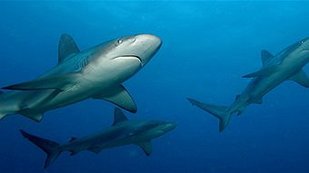 A circling shark fin is every swimmer's worst nightmare, and the recent death of surfer Zac Young near Coffs Harbour has refocused our emotions on the danger that lurks beneath. But are we really at risk? And if we are, do shark nets - our current shark prevention strategy - actually work? Shark meshing off Sydney's beaches was introduced in 1937 following a series of fatal shark attacks, including several on the Northern Peninsula. Most people think the nets are to stop sharks reaching popular beaches, but that's not true. The nets are there to kill sharks - specifically big (two metre long) sharks. Not only is this a controversial practice at a time when we are trying to protect Australia's declining shark population, but the nets kills a huge number of other marine creatures as well. Late last month, a whale calf drowned after it became entangled in a shark net off Mona Vale Beach. And so far this season, six whales have been caught, and luckily rescued, from shark nets off Queensland. Added up over several years, the carnage is sickening. Over the last 20 years almost 4000 sea creatures have been caught in shark nets off the NSW coast alone. Of these, less than 150 were "target" species - great white or tiger sharks. A massive 96 per cent of deaths were "bycatch" - giving a total of 3795 dead dolphins, turtles, whales, seals, stingrays, penguins, dugongs and harmless sharks. In a further irony it's reported that 35 - 50 per cent of sharks caught in the nets are on the beach side. However the meshing program, which is run by the NSW Department of Primary Industries, has plenty of defenders. Most point to the fact that there has only been one fatal shark attack in the meshed area, which includes beaches from Newcastle to Wollongong, since the program began. And that's despite the huge popularity of our part of the coast, which is enjoyed by 2 million people every summer season. But Dave Thomas, founder of local conservation group Eco Divers, isn't buying. "The risk of having a shark encounter is infinitesimally small," he said. "There are five fatalities in the world per year. There are a lot of things that will get you before that - hippos, vending machines, coconuts." Mr Thomas says the nets, which are 150m long, six metres high and sit in 10-12m of water, are by no good as a barrier as sharks can swim around or over them. What the nets do do well, is act as "indiscriminate killers of everything". He has the support of Surf Life Saving NSW which, along with marine ecologists and environmental and animal welfare groups, is calling for more research into alternative shark protection measures. Ideas already on the table include radio signals, sonar technology, electric nets and swimmer education. There's no debate that swimmers should avoid swimming at dusk, dawn or in murky water. They should also stay out of the water when schools of bait fish are about, to avoid being accidentally bitten by a shark in a "feeding frenzy". As well, shark nets were introduced in an era when our coastal waters were often dirty and sometimes contaminated with offal and blood, which meatworks used to dispose of in public waterways. The situation is so different now, surely our swimmer safety approach should change too. Good For Manly supports research into alternatives to shark meshing. In the meantime we believe the shark mesh season should be shortened. The nets are currently in place between September 1 and April 30, which overlaps the whale migration season from late April to November. This is our debate. There are shark nets off Queenscliff, North Steyne and Manly. Let us know what you think. Help us take a fair shark net proposal to Manly Council early next year.
4 Comments
30/12/2013 03:02:49 pm
most of what Candy has stated is true but the nets were actually put in during 1937 as a temporary measure to cull the number of sharks and reduce [they thought] the risk of some embarrassing incident during the 150 anniversary of NSW. The nets are gill nets .. indiscriminate in what they catch, deployed by fishermen contractors .. the amount of marine life caught has also been drastically understated and mis-discribed. Independent observers were only put on the vessels in the late 1990s. Most of the early fatalities were as a result of lack of medical attention not the injuries sustained. What should always be stressed when talk shark interactions and safety is the fishing activity in the area .. bait, burly, dying fish and cleaning fish attracts predators !
Reply
Candy Bingham
2/1/2014 06:54:04 am
Thanks Dave for this updated material on the shark nets and thanks also to you and your team at Eco Divers who do such a fantastic job cleaning up the rubbish from ocean and harbour
Reply
Hi
11/6/2018 11:01:50 am
Yo
Dick
11/6/2018 11:00:51 am
Hi
Reply
Leave a Reply. |
AuthorCandy Bingham, Deputy Mayor & Manly Ward Councillor on Northern Beaches Council. Background in marketing, public relations and community engagement. Author of five business books. Former Lady Mayoress of Sydney. Aka Candy Tymson. ........................................
View Videos
|
|
Contact our team |
Site design by Manly Mac Art.
We acknowledge the Traditional Owners of the Northern Beaches and pay our respects to Elders past, present and emerging.
Authorised by Jonathan Trope, 1/90 Lauderdale Ave, Fairlight 2094

 RSS Feed
RSS Feed


